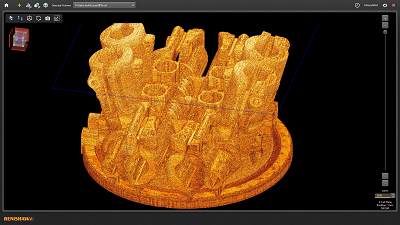
InfiniAM Spectral screen shot-3D data reveal
This process must be highly accurate to produce a functional part. However, there are sources of variation that can occur during the build process, which can produce anomalies that impact the longevity of the part. Real-time spectral monitoring technology enables manufacturers to gather melt-pool data to enable traceable production and process optimisation.
To allow additive manufacturing (AM) users a greater understanding of their processes, Renishaw has developed new process monitoring software, InfiniAM Spectral, for use on its systems. After its successful launch at formnext 2017, the company released the software package to help manufacturers overcome the barriers to AM in critical applications, process stability and part quality.
InfiniAM Spectral is part of a developing family of products that helps users capture, evaluate and store process data from LPBF technologies. The software enables data capture, presentation and analysis, representing a powerful tool for developing a deep understanding of the AM process.
The new software offers two measurement functions in the sensor modules. The first module, LaserVIEW, uses a photosensitive diode to measure the intensity of the laser energy. The second module, MeltVIEW, captures emissions from the melt pool in the near-infrared and infrared spectral ranges. These two sensor signals can be compared to help identify discrepancies.
MeltVIEW and LaserVIEW stream data across a conventional computer network on a layer-by-layer basis, so manufacturers can analyse process monitoring data in real-time. As the build progresses, the data is rendered live in 3D for viewing in InfiniAM Spectral. The engineer can compare the data from each sensor to identify any deviations, which may indicate the presence of anomalies that could lead to defects.
“For additive manufacturing to become a truly ubiquitous manufacturing technology, users and practitioners require a deep understanding of the process,” explained Robin Weston, Marketing Manager at Renishaw's Additive Manufacturing Products Division. “The software will be hugely beneficial to manufacturers looking to achieve consistent processing with AM.”
“The amount of process data generated during an AM build is immense, which means it can be difficult to make practical use of it without the correct interpretation tools,” continued Weston. “InfiniAM Spectral enables manufacturers to easily interpret data and gain a more detailed understanding of their AM processes. Access to real-time data opens the door to future developments in process control – detecting and correcting problems in real-time.”
InfiniAM Spectral will be a huge asset to those producing a series of identical parts in high-value applications. When producing the first part in a series, data from LaserVIEW and MeltVIEW can be compared with existing X-Ray or Computed Tomography (CT) data from a known good part. The manufacturer can use this gold standard signal data and can compare it against data from subsequent parts to judge quality and consistency.
Guide to AM
The UK-based company also launched a dedicated AM Guide on its website. It will use the new information hub to educate and inform customers and the wider engineering community using videos, case studies, feature articles, industry news and opinion pieces. They plan to educate readers on the possibilities of additive manufacturing and its business impact, to increase uptake of the technology in mainstream manufacturing.
The dedicated AM content zone contains a collection of technical articles written by the company’s industry experts, including popular AM LinkedIn blogger, Marc Saunders and Lucy Grainger, an expert in metal powders for AM. The content covers the business impact of AM, latest developments in the industry and detailed case studies of successful AM applications.
As part of the new section, the AM systems and software maker has published a beginner’s guide to AM, which explains how AM users can optimise metal AM designs to take advantage of the design freedom, performance and efficiency of the manufacturing technique. It also explains how accommodating AM process characteristics is essential to waste and cost reduction.
“Investing in AM requires time, resources and equipment,” explained Robin Weston, Marketing Manager at Renishaw’s Additive Manufacturing Products Division. “To understand the benefits and develop a reliable and capable process, companies must rigorously assess operations.
“We want to educate the industry on why to consider AM, when to consider it and what applications are suitable,” continued Weston. “Alongside our knowledge of AM, Renishaw has expertise in precision measurement, machining and finishing. This positions us as the perfect partner for an integrated industrial additive manufacturing solution.”















